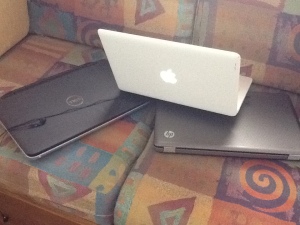 As I consider a paperless class, I first think of how easy it would be for me to access student work. I will no longer need to tote around so much paper! My back would be quite appreciative and my chiropractor fees would decrease, I am sure. Whenever students send me work via the web, now, I am able to quickly send back a response that keeps them working and interested in their task while ideas are fresh and formative. I love the idea of being able to broaden the thinking of writing to include multimedia. It is easy to include multiple intelligences as students can embed audios, videos, and performance pieces that they create as well as those of others. I love when visual/ global kids send info graphics or mind maps to explain thinking and support points they make or link to a rap or song they have composed. Paperless classes are more inclusive of learner strengths and preferences.
As I consider a paperless class, I first think of how easy it would be for me to access student work. I will no longer need to tote around so much paper! My back would be quite appreciative and my chiropractor fees would decrease, I am sure. Whenever students send me work via the web, now, I am able to quickly send back a response that keeps them working and interested in their task while ideas are fresh and formative. I love the idea of being able to broaden the thinking of writing to include multimedia. It is easy to include multiple intelligences as students can embed audios, videos, and performance pieces that they create as well as those of others. I love when visual/ global kids send info graphics or mind maps to explain thinking and support points they make or link to a rap or song they have composed. Paperless classes are more inclusive of learner strengths and preferences.
Since we are becoming a collaborative world, I think by becoming paperless we make opportunities for students to link to works of others instead of plagiarizing (sometimes unconsciously or unknowingly). I think students will find ways to extend ideas and stretch thinking by being able to quickly access information as they create in a paperless world. Quality research is a click away for connected students. We are allowing students access to multiple perspectives to broaden and reshape thinking and learning.
It certainly is easier to read and markup text online than to have to remember to bring notebooks, text books and trade books back and forth, and to take legible notes on paper or hope the bargain dollar store post-its stick where they are supposed to stick. Online work also allows students to see what passages are of importance to other readers and what others find confusing or are wondering about, as well as letting them be able to access the connections and inferences others make.
As a teacher, I welcome empowering students more. Students who are able can decide what is important to help them grow as learners and can delve into topics they are passionate about and even find and cultivate passions and interests. I imagine needing to have an excellent framework and core bank of knowledge and skills to offer students in order to let them connect to learning that is personally meaningful and feels important. I also know this will mean tech access for all learners(despite the expense), ongoing safety skill building, and ongoing learning for me in order to learn and teach online skills and methods in accordance with current, valid scientific research. Also, know I will need to be able to explain, convince, and reassure parents about a paperless space and why paperless is the way to go,i.e., how it looks and feels as well as the potentials and possibilities it can unleash.
In an independent school I do envision some downsides that would have to be figured out. Administrators can no longer walk through a classroom and find new evidence of learning by examining the walls in the classroom or checking our bulletin boards for student work. Admission tours happen in independent schools. It is hard for prospective families to get a sense of a school when the space is paperless. I noticed this transition when interactive white boards came to the school that captured the day’s lessons in a way that made the chart paper lessons and experience stories obsolete. Math problems can be easily stored in Smart boards and math thinking returned to with the click of a button. It does mean, however, unless math is happening when you walk in, the rich and detailed thinking and demonstrated problem solving trail is not explained or retraced. I also noticed the effects of going paperless when student writing and portfolios were inside of the computer instead of lined up in pizza or cereal boxes portfolios or lining shelves for someone to flip through. Even book boxes that would give a passer-byer a glimpse into the reading life of a student disappear as students use e-readers. If artwork is kept via digital portfolios instead of lining hallways and filling glass enclosed cases and wooden shelves how will it be appreciated? Perhaps there needs to be room for both. I do know that new ways to communicate learning need to be established in paperless spaces.
I see paperless spaces as a way to broaden learning networks between students, teachers, parents and administrators. Teachers do not have to be the only ones viewing, asking questions that challenge, and making positive or supportive comments. In a paperless space work can be viewed by a broader audience and the feedback can be richer, more wide-spread and more authentic. It also can allow a back and forth communication between learner and the learning network.